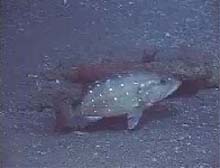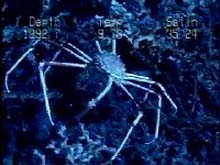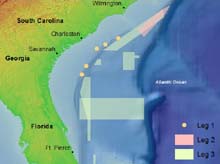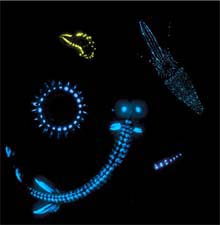Mission Plan
In 2001, the National Marine Sanctuary Program’s "Islands in the Stream" expedition explored deep-water habitats from North Carolina to the coast of Belize. Building on this work, the NOAA Office of Ocean Exploration’s "Islands in the Stream 2002: Exploring Underwater Oases" will host four scientific investigations geared toward learning more about high-relief areas along the continental shelf break and slope from the eastern coast of Florida to North Carolina – an area known as the South Atlantic Bight. These important and understudied habitats peppered throughout the region provide critically important habitat for a wide variety of marine organisms.
The expedition will use the R/V Seward Johnson and the Johnson-Sea-Link submersible, owned and operated by the Harbor Branch Oceanographic Institution (HBOI) ![]() , to provide researchers direct access to this rarely seen underwater world. Investigators also will use a variety of sampling techniques to complement the videotape and still images collected by the submersible. By extending their research into unknown areas, scientists and natural resource managers will have the opportunity to gather information that will be useful for developing new and innovative ideas for habitat and resource protection.
, to provide researchers direct access to this rarely seen underwater world. Investigators also will use a variety of sampling techniques to complement the videotape and still images collected by the submersible. By extending their research into unknown areas, scientists and natural resource managers will have the opportunity to gather information that will be useful for developing new and innovative ideas for habitat and resource protection.
Each project will be conducted by groups of interdisciplinary investigators led by scientists from the South Carolina Department of Natural Resources ![]() , North Carolina National Estuarine Research Reserve
, North Carolina National Estuarine Research Reserve ![]() , and the Harbor Branch Oceanographic Institution (HBOI). Read on to learn more about each of these projects.
, and the Harbor Branch Oceanographic Institution (HBOI). Read on to learn more about each of these projects.

Reef fishes, such as this snowy grouper, often use low-relief rock outcrops for food and cover.
Mission One
July 28-August 5
Characterization of Deep Reef Habitat, with Particular Emphasis on Discovery, Exploration and Description of Reef Fish Spawning Sites
Populations of economically valuable reef fishes have been declining for at least two decades in the South Atlantic Bight region, affecting the food chain from the top predators down to the bottom-dwelling invertebrate communities. The goal of this project is to discover and explore spawning locations of reef fishes in the area, and to describe how underlying features and oceanographic processes interact to provide habitat for associated species.
Scientists will use a submersible to collect video and still images of the shelf-edge reefs, as well as samples of sediment, rocks, and marine organisms for further analysis. Sidescan sonar will be used to determine characteristics of bottom topography at scales larger than the submersible can explore. In addition, traditional sampling methods such as towing nets, measuring conductivity, temperature and density of water, and grabbing sediment samples using instruments deployed from the deck of the ship, will be used to help identify potential spawning habitats and to further characterize these reefs. The results will support protective management strategies to sustain the exploited fish species that utilize these spawning locations.

A deep water crab at home on a deep-water Lophelia bank.
Mission Two
August 5-15
Exploration of Outer Shelf and Slope Habitats off the Carolinas.
The North Carolina Shelf consists of a wide range of habitats, many of which are rarely, if ever, visited. The existing data, however, indicate that the shelf includes numerous high-relief outcrops, ancient reefs and shorelines, and potentially extensive hard-bottom communities, all of which typically support a variety of commercially important and unique fish species. Because the data is scarce, scientists have a limited understanding of the shelf's habitats, species distribution, and ecological function.
Two adjacent but uniquely different habitats will be studied. The first will be the outer shelf hardgrounds (80-200 m deep) that are marked by a large number of high-relief reef features. The second will be the middle-slope deep corals (400-500 m deep), where Lophelia, a species of deep-water coral, forms widespread reefs. Scientists will use the submersible to collect videotape and still photographs of these areas, and samples will be collected to assess the community structure and faunal interactions. Scientist also will sample these areas by towing nets along the bottom, through mid-water, and at the surface to determine the overall ecology of these areas.
Mission Three
August 18-31
Discovery of New Resources with Pharmaceutical Potential
Natural products have always been a rich source of medicinal drugs. Traditionally, such drugs have come from terrestrial sources. It has been predicted that the marine environment, however, may contain 80% of the world’s plant and animal species. This huge potential for new medicines from our oceans has already proven to be productive, as 12 natural marine products are currently in advanced preclinical or clinical evaluation.
This project seeks to explore currently untapped sources of new drugs that may be applied in the long term to the development of compounds used to study, diagnose or treat human diseases, including cancer, infectious diseases, diseases of the immune system, cardiovascular disease, and disorders of the central nervous system. Related to this primary objective is the development of alternative methods for the production of bioactive compounds instead of harvesting them from nature.
Exploration of Vision and Bioluminescence in the Deep-sea Benthos
Scientists have observed that the eyes of highly mobile (pelagic) fish species tend to get smaller in the deep ocean. This makes sense, as there is less light further in the ocean, and therefore less need for big eyes. In contrast, the eyes of bottom (benthic) dwelling species increase with depth. Why would species living at the bottom of the ocean have such big eyes when virtually no sunlight is capable of reaching their home? What are these benthic animals seeing?
Bioluminescence is light produced by a chemical reaction within an organism. In deep-water ocean areas (below the photic zone), it is the only source of light available. In order to observe this phenomenon naturally, the science team plans to deploy a special low-light camera from the submersible. The team also will deploy baited "light-tight" traps to catch some of these benthic species for further analysis, allowing them to be brought to the surface without having their eyes damaged by the sun’s bright light. Scientists will then be able to observe and dissect the intact eyes.
Partnerships
The success of this expedition depends on partnerships, which provide an opportunity for scientists, natural resource managers, and educators from many public and private agencies and institutions to collaborate to fulfill a common set of goals and objectives. The following is a list of some of the institutions engaged in this endeavor:
NOAA, Office of Ocean Exploration
NOAA, National Ocean Service, Special Projects Office
NOAA, National Ocean Service, National Centers for Coastal Ocean Science, Center for Coastal Environmental Health and Biomolecular Research
NOAA, Office of Ocean and Atmospheric Research, National Undersea Research Program
United States Geological Survey
Harbor Branch Oceanographic Institution
North Carolina National Estuarine Research Reserve
North Carolina Division of Marine Fisheries
North Carolina Museum of Natural Sciences
South Carolina Department of Natural Resources
College of Charleston
Charleston County School of the Arts
Coastal Carolina University
South Carolina, Sandhills Intermediate School
Southampton Oceanography Centre
Duke University
Johns Hopkins University
University of Florida
University of Lund, Sweden.
Sign up for the Ocean Explorer E-mail Update List.
















































